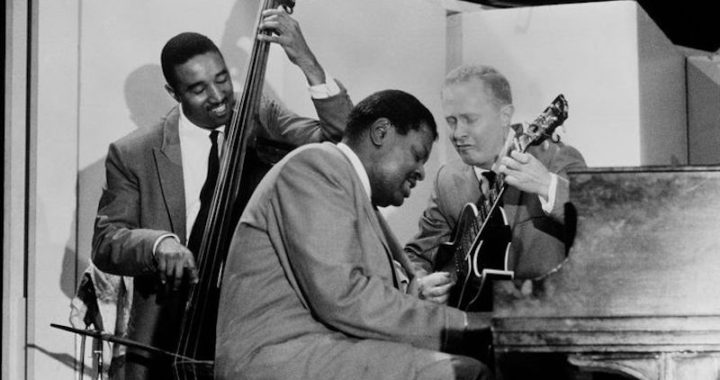If you ever listen to an old 1950s-era recording of jazz pianist Oscar Peterson, you’re probably hearing him with his trio which included Herb Ellis on guitar and Ray Brown on bass. No drummer at that time, but the three of them played with such a powerful sense of beat and rhythm that you don’t miss the drummer at all.
And if you want to hear what I mean, listen to their recording of “Swinging Till the Girls Come Home” (written by Oscar Pettiford). No drummer, but you’d swear there was.
 Songwriters are very familiar with the chorus hook, but there are other kinds to experiment with, and you will want to discover the power of layering various kinds of hooks in the same song. “Hooks and Riffs: How They Grab Attention, Make Songs Memorable, and Build Your Fan Base“ shows you how it’s done.
Songwriters are very familiar with the chorus hook, but there are other kinds to experiment with, and you will want to discover the power of layering various kinds of hooks in the same song. “Hooks and Riffs: How They Grab Attention, Make Songs Memorable, and Build Your Fan Base“ shows you how it’s done.
There are some groups, on the other hand, where you feel that if it weren’t for the drummer, the band’s sense of rhythm would be weaker. The drummer works to hold things together, and that’s not a good thing. The best use of a drummer is to add to the sound and feel of a song, not to repair errors.
I’m mentioning this because there is a similar situation that occurs in the songwriting world, where musical weaknesses within a song require fixing, and where those weaknesses are repaired by the producer during the production of the recording.
A Good Producer
A good producer is often dealing with things that songwriters can’t necessarily deal with at the songwriting stage, and it’s an important part of their job.
For example, it’s an important principle that songs maintain or gain musical energy as they progress. That’s one that a producer can easily deal with, and it usually means manipulating instrumental sounds and volume.
But here’s an issue (a principle, actually) that songwriters can deal with: a verse melody typically wanders low in the singer’s range, and then it moves upward to include higher notes, particularly as it gets ready to join to the chorus.
If a songwriter doesn’t know that that principle is important — the upward-moving melody — it can be dealt with at the production stage, and usually means that a producer tries to build musical energy, again by manipulating aspects of the music during recording and/or mixing.
But — and this is why I’m bringing this up — songwriting issues are best dealt with at the songwriting stage, not the production stage. Good production helps support those aspects of music, doesn’t try to create them in their absence.
How do you know you’ve got a song that is the best it can be? Try making a recording of it as an unaccompanied, solo voice song.
If you like how the melodies work, then record it again, adding in a simple chord progression using guitars and/or keyboards. Does it still work? Do you like what you hear? Do the rhythms, chords, melodies and lyrics all support the general intent of the song? Those song elements are the most important part of what makes a song really work, from a structural point of view.
If you can still say yes to all that, then you’ve got a song that’s ready for everything else that typically goes with producing music in your chosen genre.
There’s nothing quite so important as getting a song to work well at this bare-bones level. Once it works, everything you add to it works to support those great song elements.
In a way, production can be like the drummer in a band: it can fix errors, but its best use is to support songs and make them better, not repair them.
 Written by Gary Ewer. Follow Gary on Twitter.
Written by Gary Ewer. Follow Gary on Twitter.
 “The Essential Secrets of Songwriting” eBook bundle comes with a free copy of “Use Your Words! Developing a Lyrics-First Songwriting Process,” along with a Study Guide. Learn how to make the writing of a good lyric the starting point for your own songwriting method.
“The Essential Secrets of Songwriting” eBook bundle comes with a free copy of “Use Your Words! Developing a Lyrics-First Songwriting Process,” along with a Study Guide. Learn how to make the writing of a good lyric the starting point for your own songwriting method.










